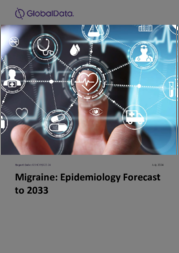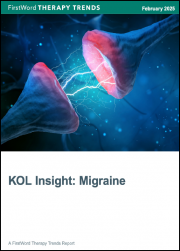
|
시장보고서
상품코드
1543782
편두통 : 역학 예측(-2033년)Migraine: Epidemiology Forecast to 2033 |
||||||
편두통은 격렬하고 쇠약해지는 두통을 특징으로 하는 흔한 신경 질환입니다. 편두통은 보통 편측성 맥박이 뛰거나 욱신거리는 통증으로 나타나며, 중등도에서 중증의 범위로 나타나며, 신체 활동으로 인해 악화됩니다. 다른 흔한 증상으로는 메스꺼움, 구토, 빛에 대한 과민반응(광공포증), 소리에 대한 과민반응(음공포증) 등이 있습니다. 국제두통분류 3판(ICHD-3)의 기준에 따르면 편두통은 두통에 선행하거나 때때로 동반되는 특징적인 일시적인 국소 신경증상의 존재 여부에 따라 전조증상이 있는 편두통과 전조증상이 없는 편두통의 두 가지 유형으로 나뉩니다. 전조증상이 있는 편두통의 증상으로는 섬광이나 번개와 같은 시각 장애, 언어 장애 등이 있습니다. 경우에 따라 편두통 발작 중 하나 이상의 팔다리가 마비되는 경우도 있습니다. 편두통은 전조, 조짐, 발작, 후유증 등 4단계로 나뉩니다. 하지만 모든 편두통 환자가 이 모든 단계를 경험하는 것은 아닙니다. 각 단계의 지속 기간은 개인마다, 그리고 편두통 에피소드마다 다를 수 있습니다. 편두통의 빈도에 따라 편두통은 한 달에 15일 미만의 두통이 발생하는 일과성 편두통과 한 달에 15일 이상의 두통이 발생하는 만성 편두통으로 분류할 수 있습니다. 편두통의 정확한 원인은 밝혀지지 않았지만, 뇌간의 변화나 주요 통증 경로인 삼차신경과의 상호작용 등 다양한 요인으로 인해 발생하는 것으로 보입니다. 또한, 뇌의 세로토닌 수치가 감소하면 두개골 혈관이 확장되어 편두통이 유발되는 것으로 알려져 있습니다. 편두통의 가족력이 흔한 위험요인이기 때문에 유전적 요인도 영향을 미칩니다.
주요 7개국 시장에서 12개월간 편두통 환자 수는 2023년 7,422만 6,117명에서 2033년 7,545만 2,770명으로 연평균 성장률(AGR)은 0.17%입니다. 2033년 미국은 12개월간 편두통 환자 수가 4,390만 4,470명으로 주요 7개국 시장 중 가장 많을 것이며, 일본은 12개월 유병자 수가 400만 2,331명으로 가장 적을 것입니다. 주요 7개국 시장의 12개월간 편두통 유병자 수 증가는 각 시장의 인구 통계학적 요인에 기인한 것으로 분석됐습니다.
주요 7개국 시장의 편두통 12개월 진단 유병자 수는 AGR 2.00%로 증가해 2023년 3,261만 2,840명에서 2033년 3,915만 9,484명으로 증가할 것으로 예상됩니다. 2033년에는 미국이 2,222만 9,726명으로 주요 7개국 시장에서 가장 많고, 일본은 181만 7,962건으로 가장 적습니다.
이 보고서는 주요 8개 국가(미국, 프랑스, 독일, 이탈리아, 스페인, 영국, 일본, 캐나다)의 편두통 위험 요인, 동반 질환, 세계 및 과거 역학 동향을 개괄하고, 편두통 진단 사례 및 진단 유병률에 대한 10년간의 역학 전망 등을 정리하고 있습니다.
목차
제1장 편두통 : 주요 요약
제2장 역학
- 질병 배경
- 위험요인과 병존질환
- 세계의 동향
- 주요 7개국 시장 예측 조사 방법
- 정보 출처
- 예측 가정과 방법
- 12개월간 편두통 총이환수
- 12개월간 편두통 총이환수(빈도별)
- 12개월간 편두통 총이환수(유형별)
- 12개월간 진단된 편두통 유병률
- 12개월간 진단된 편두통 유병률(빈도별)
- 12개월간 진단된 편두통 유병률(유형별)
- 편두통 역학 예측(2023-2033년)
- 12개월간 편두통 총이환수
- 12개월간 편두통 총이환수(연령별)
- 12개월간 편두통 총이환수(성별)
- 12개월간 편두통 총이환수(빈도별)
- 12개월간 편두통 총이환수(유형별)
- 12개월간 진단된 편두통 유병률
- 12개월간 진단된 편두통 유병률(연령별)
- 12개월간 진단된 편두통 유병률(성별)
- 12개월간 진단된 편두통 유병률(빈도별)
- 12개월간 진단된 편두통 유병률(유형별)
- 논의
- 역학 예측 인사이트
- COVID-19의 영향
- 분석의 한계
- 분석의 강점
제3장 부록
ksm 24.09.05Migraine is a prevalent neurological disorder marked by intense, debilitating headaches. It typically presents as a unilateral, pulsating, or throbbing pain that ranges from moderate to severe and is exacerbated by physical activity. Other common symptoms include nausea, vomiting, sensitivity to light (photophobia), and sensitivity to sound (phonophobia). According to the International Classification of Headache Disorders, Third Edition (ICHD-3) criteria, migraines are classified into two types based on the presence of characteristic transient focal neurological symptoms that usually precede or sometimes accompany the headache: migraine with aura and migraine without aura (Olesen, 2018). The symptoms of migraine with aura include visual disturbances such as flashing lights or lightning streaks, as well as language and speech difficulties. In some cases, one or more limbs may become numb during a migraine attack (Olesen, 2018). Migraine can be divided into four stages: prodrome, aura, attack, and postdrome. However, not everyone with migraine experiences all these stages. The duration of each stage varies both among individuals and between different migraine episodes (Goadsby et al., 2017). Based on the frequency of headaches, migraine can be classified into two types: episodic migraine, which occurs on fewer than 15 headache days per month, and chronic migraine, which occurs on 15 or more headache days per month (Buse et al., 2012; Olesen, 2018). Although the exact cause of migraine is unknown, it seems to result from various factors, including changes in the brainstem and its interactions with the trigeminal nerve, a major pain pathway. Additionally, a decrease in serotonin levels in the brain leads to the dilation of cranial blood vessels, which is considered a trigger for migraine (Goadsby et al., 2017). Genetic factors also contribute, as a family history of migraine is a common risk factor (Lateef et al., 2015).
In the 7MM, the 12-month total prevalent cases of migraine are expected to increase from 74,226,117 cases in 2023 to 75,452,770 cases in 2033, at an Annual Growth Rate (AGR) of 0.17%. In 2033, the US will have the highest number of 12-month total prevalent cases of migraine in the 7MM, with 43,904,470 cases, while Japan will have the fewest 12-month total prevalent cases with 4,002,331 cases. GlobalData epidemiologists attribute the increase in the 12-month total prevalent cases of migraine in the 7MM to population dynamics in each market.
The 12-month diagnosed prevalent cases of migraine in the 7MM are expected to increase from 32,612,840 cases in 2023 to 39,159,484 cases in 2033, at an AGR of 2.00%. In 2033, the US will have the highest number of 12-month diagnosed prevalent cases of migraine in the 7MM, with 22,229,726 cases, whereas Japan will have the fewest 12-month diagnosed prevalent cases with 1,817,962 cases.
Scope
- This report provides an overview of the risk factors, comorbidities, and the global and historical epidemiological trends for migraine in the seven major markets (7MM: US, France, Germany, Italy, Spain, UK, and Japan). The report includes a 10-year epidemiology forecast for the 12-month total prevalent cases and 12-month diagnosed prevalent cases of migraine. The 12-month total prevalent cases and 12-month diagnosed prevalent cases of migraine are segmented by age (18 years and older), sex, and subtype (migraine with aura and migraine without aura). The report also includes the 12-month total and 12-month diagnosed prevalent cases of migraine further segmented by migraine frequency into episodic migraine and chronic migraine for both sexes and ages 18 years and older. This epidemiology forecast for migraine is supported by data obtained from peer-reviewed articles and population-based studies based on the ICHD-3 criteria. The forecast methodology was kept consistent across the 7MM to allow for a meaningful comparison of the 12-month total prevalent cases and 12-month diagnosed prevalent cases of migraine across these markets.
Reasons to Buy
The Migraine epidemiology series will allow you to -
- Develop business strategies by understanding the trends shaping and driving the global Migraine market.
- Quantify patient populations in the global Migraine market to improve product design, pricing, and launch plans.
- Organize sales and marketing efforts by identifying the age groups that present the best opportunities for Migraine therapeutics in each of the markets covered.
Table of Contents
Table of Contents
1 Migraine: Executive Summary
- 1.1 Catalyst
- 1.2 Related reports
- 1.3 Upcoming reports
2 Epidemiology
- 2.1 Disease background
- 2.2 Risk factors and comorbidities.
- 2.3 Global and historical trends
- 2.4 7MM forecast methodology.
- 2.4.1 Sources
- 2.4.2 Forecast assumptions and methods.
- 2.4.3 12-month total prevalent cases of migraine
- 2.4.4 12-month total prevalent cases of migraine by frequency
- 2.4.5 12-month total prevalent cases of migraine by type
- 2.4.6 12-month diagnosed prevalent cases of migraine
- 2.4.7 12-month diagnosed prevalent cases of migraine by frequency
- 2.4.8 12-month diagnosed prevalent cases of migraine by type
- 2.5 Epidemiological forecast for migraine (2023-2033)
- 2.5.1 12-month total prevalent cases of migraine
- 2.5.2 Age-specific 12-month total prevalent cases of migraine
- 2.5.3 Sex-specific 12-month total prevalent cases of migraine
- 2.5.4 12-month total prevalent cases of migraine by frequency
- 2.5.5 12-month total prevalent cases of migraine by type
- 2.5.6 12-month diagnosed prevalent cases of migraine
- 2.5.7 Age-specific 12-month diagnosed prevalent cases of migraine.
- 2.5.8 Sex-specific 12-month diagnosed prevalent cases of migraine.
- 2.5.9 12-month diagnosed prevalent cases of migraine by frequency
- 2.5.10 12-month diagnosed prevalent cases of migraine by type
- 2.6 Discussion
- 2.6.1 Epidemiological forecast insight
- 2.6.2 COVID-19 impact.
- 2.6.3 Limitations of the analysis
- 2.6.4 Strengths of the analysis
3 Appendix
- 3.1 Bibliography
- 3.2 Primary research - KOLs interviewed for this report.
- 3.2.1 KOLs.
- 3.3 Primary research - prescriber survey
- 3.4 About the authors
- 3.4.1 Epidemiologist
- 3.4.2 Reviewers
- 3.4.3 Vice President of Disease Intelligence and Epidemiology
- 3.4.4 Global Head of Pharma Research, Analysis, and Competitive Intelligence
- Contact Us

















